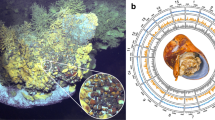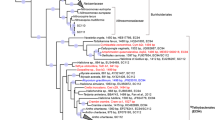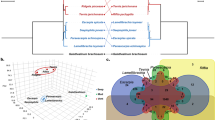Abstract
Symbioses between bacteria and eukaryotes are ubiquitous, yet our understanding of the interactions driving these associations is hampered by our inability to cultivate most host-associated microbes. Here we use a metagenomic approach to describe four co-occurring symbionts from the marine oligochaete Olavius algarvensis, a worm lacking a mouth, gut and nephridia. Shotgun sequencing and metabolic pathway reconstruction revealed that the symbionts are sulphur-oxidizing and sulphate-reducing bacteria, all of which are capable of carbon fixation, thus providing the host with multiple sources of nutrition. Molecular evidence for the uptake and recycling of worm waste products by the symbionts suggests how the worm could eliminate its excretory system, an adaptation unique among annelid worms. We propose a model that describes how the versatile metabolism within this symbiotic consortium provides the host with an optimal energy supply as it shuttles between the upper oxic and lower anoxic coastal sediments that it inhabits.
This is a preview of subscription content, access via your institution
Access options
Subscribe to this journal
Receive 51 print issues and online access
$199.00 per year
only $3.90 per issue
Buy this article
- Purchase on Springer Link
- Instant access to full article PDF
Prices may be subject to local taxes which are calculated during checkout




Similar content being viewed by others
Change history
26 October 2006
In the advance online publication version of this Article, author Marcel Huntemann’s surname was misspelled as ‘Hunteman’. This was corrected on 26 October 2006.
References
Margulis, L. Symbiosis in Cell Evolution (W. H. Freeman, New York, 1993)
Ruby, E. G., Henderson, B. & McFall-Ngai, M. We get by with a little help from our (little) friends. Science 303, 1305–1307 (2004)
DeLong, E. F. Microbial population genomics and ecology. Curr. Opin. Microbiol. 5, 520–524 (2002)
Handelsman, J. Metagenomics: application of genomics to uncultured microorganisms. Microbiol. Mol. Biol. Rev. 68, 669–685 (2004)
Riesenfeld, C. S., Schloss, P. D. & Handelsman, J. Metagenomics: genomic analysis of microbial communities. Annu. Rev. Genet. 38, 525–552 (2004)
DeLong, E. F. et al. Community genomics among stratified microbial assemblages in the ocean’s interior. Science 311, 496–503 (2006)
Hallam, S. J. et al. Reverse methanogenesis: testing the hypothesis with environmental genomics. Science 305, 1457–1462 (2004)
Tyson, G. W. et al. Community structure and metabolism through reconstruction of microbial genomes from the environment. Nature 428, 37–43 (2004)
Venter, J. C. et al. Environmental genome shotgun sequencing of the Sargasso Sea. Science 304, 66–74 (2004)
Tringe, S. G. et al. Comparative metagenomics of microbial communities. Science 308, 554–557 (2005)
Wu, D. et al. Metabolic complementarity and genomics of the dual bacterial symbiosis of sharpshooters. PLoS Biol. 4, e188 (2006)
Dubilier, N., Blazejak, A. & Ruhland, C. Symbioses between bacteria and gutless marine oligochaetes. Prog. Mol. Subcell. Biol. 41, 251–275 (2006)
Blazejak, A., Erseus, C., Amann, R. & Dubilier, N. Coexistence of bacterial sulfide oxidizers, sulfate reducers, and spirochetes in a gutless worm (Oligochaeta) from the Peru margin. Appl. Environ. Microbiol. 71, 1553–1561 (2005)
Dubilier, N. et al. Endosymbiotic sulphate-reducing and sulphide-oxidizing bacteria in an oligochaete worm. Nature 411, 298–302 (2001)
Aparicio, S. et al. Whole-genome shotgun assembly and analysis of the genome of Fugu rubripes.. Science 297, 1301–1310 (2002)
Medini, D., Donati, C., Tettelin, H., Masignani, V. & Rappuoli, R. The microbial pan-genome. Curr. Opin. Genet. Dev. 15, 589–594 (2005)
Mowat, C. G. et al. Octaheme tetrathionate reductase is a respiratory enzyme with novel heme ligation. Nature Struct. Mol. Biol. 11, 1023–1024 (2004)
van den Ende, F. P., Meier, J. & van Gemerden, H. Syntrophic growth of sulfate-reducing bacteria and colorless sulfur bacteria during oxygen limitation. FEMS Microbiol. Ecol. 23, 65–80 (1997)
Matias, P. M., Pereira, I. A., Soares, C. M. & Carrondo, M. A. Sulphate respiration from hydrogen in Desulfovibrio bacteria: a structural biology overview. Prog. Biophys. Mol. Biol. 89, 292–329 (2005)
Kletzin, A. & Adams, M. W. Molecular and phylogenetic characterization of pyruvate and 2-ketoisovalerate ferredoxin oxidoreductases from Pyrococcus furiosus and pyruvate ferredoxin oxidoreductase from Thermotoga maritima.. J. Bacteriol. 178, 248–257 (1996)
Cavanaugh, C. M., McKiness, Z. P., Newton, I. L. G. & Stewart, F. J. Marine chemosynthetic symbioses. In The Prokaryotes: A Handbook on the Biology of Bacteria (eds Dworkin, M. et al.) (Springer, New York, 2006)
Liu, J. Y., Miller, P. F., Gosink, M. & Olson, E. R. The identification of a new family of sugar efflux pumps in Escherichia coli.. Mol. Microbiol. 31, 1845–1851 (1999)
Giere, O. & Erseus, C. Taxonomy and new bacterial symbioses of gutless marine Tubificidae (Annelida, Oligochaete) from the island of Elba (Italy). Org. Divers. Evol. 2, 289–297 (2002)
De Cian, M., Regnault, M. & Lallier, F. H. Nitrogen metabolites and related enzymatic activities in the body fluids and tissues of the hydrothermal vent tubeworm Riftia pachyptila.. J. Exp. Biol. 203, 2907–2920 (2000)
Khademi, S. et al. Mechanism of ammonia transport by Amt/MEP/Rh: structure of AmtB at 1.35 Å. Science 305, 1587–1594 (2004)
Yancey, P. H., Blake, W. R. & Conley, J. Unusual organic osmolytes in deep-sea animals: adaptations to hydrostatic pressure and other perturbants. Comp. Biochem. Physiol. A 133, 667–676 (2002)
Denger, K., Ruff, J., Schleheck, D. & Cook, A. M. Rhodococcus opacus expresses the xsc gene to utilize taurine as a carbon source or as a nitrogen source but not as a sulfur source. Microbiology 150, 1859–1867 (2004)
Yang, C. C., Packman, L. C. & Scrutton, N. S. The primary structure of Hyphomicrobium X dimethylamine dehydrogenase. Relationship to trimethylamine dehydrogenase and implications for substrate recognition. Eur. J. Biochem. 232, 264–271 (1995)
Paul, L. & Ferguson, D. J. Jr. Krzycki, J. A. The trimethylamine methyltransferase gene and multiple dimethylamine methyltransferase genes of Methanosarcina barkeri contain in-frame and read-through amber codons. J. Bacteriol. 182, 2520–2529 (2000)
Cohen, S. S. A Guide to the Polyamines (Oxford Univ. Press, New York, 1998)
Kelly, D. J. & Thomas, G. H. The tripartite ATP-independent periplasmic (TRAP) transporters of bacteria and archaea. FEMS Microbiol. Rev. 25, 405–424 (2001)
Moran, N. A. Microbial minimalism: genome reduction in bacterial pathogens. Cell 108, 583–586 (2002)
Moran, N. A. Tracing the evolution of gene loss in obligate bacterial symbionts. Curr. Opin. Microbiol. 6, 512–518 (2003)
Moran, N. A. & Plague, G. R. Genomic changes following host restriction in bacteria. Curr. Opin. Genet. Dev. 14, 627–633 (2004)
Huntemann, M. MetaClust—Entwicklung eines modularen Programms zum Clustern von Metagenomfragmenten anhand verschiedener intrinsischer DNA-Signaturen. Diploma thesis, Univ. Bremen. (2006)
Meyer, F. et al. GenDB—an open source genome annotation system for prokaryote genomes. Nucleic Acids Res. 31, 2187–2195 (2003)
Quast, C. MicHanThi—Design and Implementation of a System for the Prediction of Gene Functions in Genome Annotation Projects. Diploma thesis, Univ. Bremen. (2006)
Markowitz, V. M. et al. The integrated microbial genomes (IMG) system. Nucleic Acids Res. 34, D344–D348 (2006)
Teeling, H., Waldmann, J., Lombardot, T., Bauer, M. & Glockner, F. O. TETRA: a web-service and a stand-alone program for the analysis and comparison of tetranucleotide usage patterns in DNA sequences. BMC Bioinformatics 5, 163 (2004)
Acknowledgements
This work was performed under the auspices of the US Department of Energy’s Office of Science, Biological and Environmental Research Program, and supported by the University of California Lawrence Livermore National Laboratory, Lawrence Berkeley National Laboratory, and Los Alamos National Laboratory, and the Max Planck Society. We thank members of the Rubin, J. Bristow and P. Hugenholtz laboratories, as well as members of the Joint Genome Institute, for their contributions. We thank V. Markowitz, E. Dalin, N. Putnam, R. Sorek, T. Glavina del Rio, A. Salamov, A. Kobayashi and K. Kellaris for their assistance. At the Max Planck Institute for Marine Microbiology we thank S. Wetzel for technical assistance. We are grateful to C. Lott and the staff of the HYDRA field station at Elba for their generous support and help in sampling the worms.
Author information
Authors and Affiliations
Corresponding authors
Ethics declarations
Competing interests
The assembled sequences from the Olavius symbionts’ metagenome have been deposited into the NCBI database under the project accession number AASZ00000000. The annotated Olavius symbionts’ bins were incorporated into the metagenomics version of the US Department of Energy Joint Genome Institute Integrated Microbial Genomes/M (IMG/M; http://img.jgi.doe.gov/m). Reprints and permissions information is available at www.nature.com/reprints. The authors declare no competing financial interests.
Supplementary information
Supplementary Notes
This file contains Supplementary Methods, Supplementary Figures 1–4, Supplementary Tables 1–6, Supplementary Discussion and additional references. In the original Supplementary Information posted on 17 September 2006, an incorrect weblink was given. The web link for the Java TreeView was posted as http://genetics.stanford.edu/~alok/TreeView/. The correct link is http://jtreeview.sourceforge.net/ (page 6, 2nd paragraph in the section “Binning”) This note was updated on 26 October 2006. (PDF 655 kb)
Rights and permissions
About this article
Cite this article
Woyke, T., Teeling, H., Ivanova, N. et al. Symbiosis insights through metagenomic analysis of a microbial consortium. Nature 443, 950–955 (2006). https://doi.org/10.1038/nature05192
Received:
Accepted:
Published:
Issue Date:
DOI: https://doi.org/10.1038/nature05192
This article is cited by
-
Taurine as a key intermediate for host-symbiont interaction in the tropical sponge Ianthella basta
The ISME Journal (2023)
-
Environments and Hosts Structure the Bacterial Microbiomes of Fungus-Gardening Ants and their Symbiotic Fungus Gardens
Microbial Ecology (2023)
-
Fidelity varies in the symbiosis between a gutless marine worm and its microbial consortium
Microbiome (2022)
-
Differential regulation of degradation and immune pathways underlies adaptation of the ectosymbiotic nematode Laxus oneistus to oxic-anoxic interfaces
Scientific Reports (2022)
-
Droplet microfluidics-based high-throughput bacterial cultivation for validation of taxon pairs in microbial co-occurrence networks
Scientific Reports (2022)
Comments
By submitting a comment you agree to abide by our Terms and Community Guidelines. If you find something abusive or that does not comply with our terms or guidelines please flag it as inappropriate.



